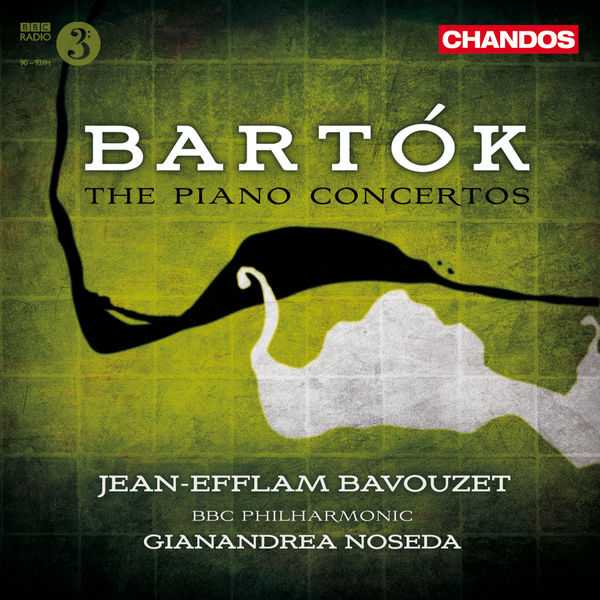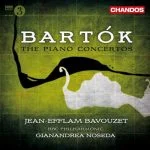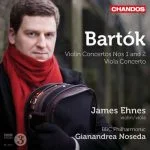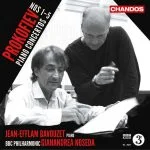

Composer: Béla Bartók
Performer: Jean-Efflam Bavouzet
Orchestra: BBC Philharmonic Orchestra
Conductor: Gianandrea Noseda
Format: FLAC (tracks)
Label: Chandos
Catalogue: CHAN10610
Release: 2010
Size: 1.17 GB
Recovery: +3%
Scan: yes
Piano Concerto No. 1, BB 91, Sz. 83
01. I. Allegro moderato
02. II. Andante
03. III. Allegro molto
Piano Concerto No. 2, BB 101, Sz. 95
04. I. Allegro
05. II. Adagio – Piu adagio – Presto
06. III. Allegro molto
Piano Concerto No. 3, BB 127, Sz. 119
07. I. Allegretto
08. II. Adagio religioso
09. III. Allegro vivace
This is the first concerto recording by Jean-Efflam Bavouzet for Chandos. Following the tremendous success of his complete Debussy piano music edition (‘This could well be the finest and most challenging of all Debussy piano cycles’ – Bryce Morrison, Gramophone) – which scooped awards from both Gramophone and BBC Music – and the launch of his ambitious Haydn Piano Sonatas series, the pianist now turns his attention to some of the mightiest concertos of the twentieth century. The three Bartók Piano Concertos on a single CD represents superb value for money.
Bartók wrote his First Concerto, one of his most challenging works, in 1926. The percussive piano writing ads much bite to the textures. The first movement is striking in its rhythmic vigour and dramatic character. The central Andante is essentially a dialogue between the soloist and four percussion players and features much atmospheric ‘Night Music’. In the finale, following without a break, the brilliant motoric rhythms of the first movement return, as does the dramatic use of percussion in a thrilling mêlée of sound.
The Second Concerto was first performed in 1933. The music is more melodically appealing and in the first movement, which is notably contrapuntal, the strings are silent throughout. The hushed slow movement on strings is interrupted half way through by a brilliant and startling scherzo, with a striking sequence of tremolos and note-clusters, before the haunting quiet mood of the opening returns. The finale, again with brilliant use of percussion (as well as brass), ends the work in virtuoso fashion.
The Third Concerto was written at the end of the composer’s life, in 1945, and is much more restrained than the previous piano concertos. The work is lighter, airy, and almost neo-classical compared to much of his earlier music. Unlike much of Bartók’s output, the piece was not composed on commission, but was rather created as a surprise birthday gift for Bartók’s second wife, Ditta Pásztory, who was, like Bartók, a skilled concert pianist. The two lively outer movements, full of the composer’s distinctive rhythmic drive, are separated by a slow movement of great beauty and serenity, with, again, a striking, contrasting middle section. The final seventeen bars were orchestrated by the composer’s pupil, Tibor Serly, after the composer’s death, based on Bartók’s notes.
Written over a span of nearly 20 years, Bartók’s three piano concertos were composed not at the behest of other performers as the violin and viola concertos were, but for the composer himself. Much like the virtuoso composer/performers of earlier generations, Bartók composed his three monumental concertos to take on concert tours and, of course, to generate income. Each of the concertos closely adheres to the Classical three-movement structure exemplified by Beethoven, even concluding each work with a rondo movement. The motivic development, use of modes, and incorporation of other musical forms is all Bartók’s own. This Chandos album of the three Bartók concertos features pianist Jean-Efflam Bavouzet who completed an immensely successful complete survey of the Debussy complete solo piano works. Though Debussy and Bartók are stylistically quite different, the attributes that so distinguished his Debussy performances — broad range of colors, meticulously controlled touch, transparent articulation, effortless control of tempo — make for brilliant Bartók as well. Accompanied by the BBC Philharmonic under Gianandrea Noseda, Bartók’s muscular orchestral writing and continuous dialogue (or arguments, as the case may be) between soloist and orchestra are seamless and cohesive. Even during the most brash, forceful brass fanfares, Noseda maintains a keen sense of balance that always allows Bavouzet’s powerful sound to ring through. Conversely, the intimate, hushed sound quality achieved in the Second Concerto’s Adagio is enough to make listeners want to hold their breath. After listening to such satisfying performances, listeners will be left hoping that Chandos has more plans for Bavouzet and Bartók.



